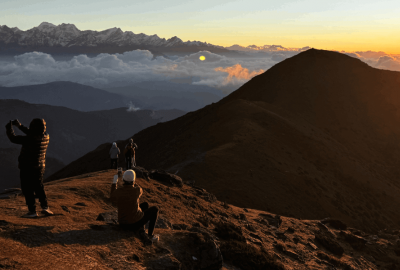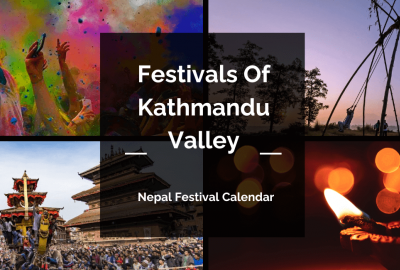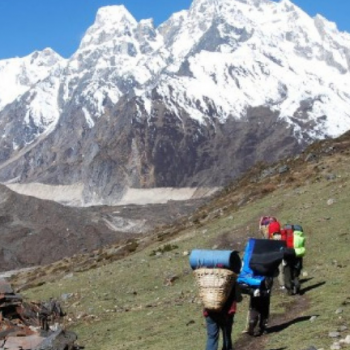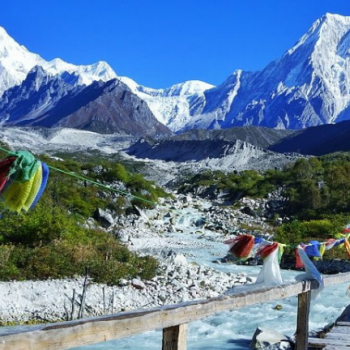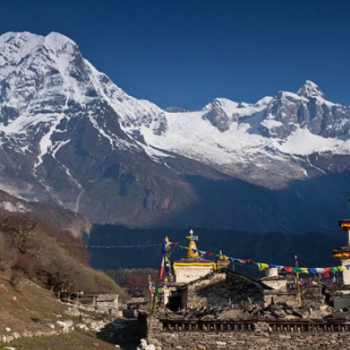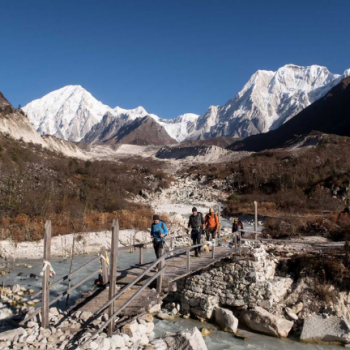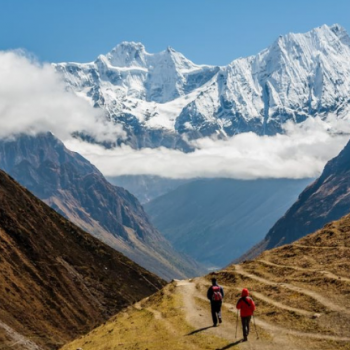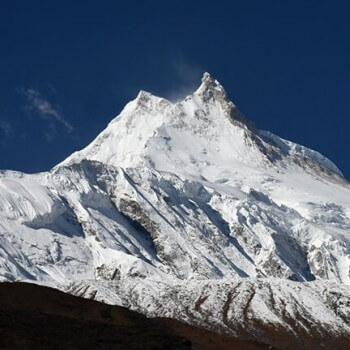The Manaslu Circuit Trek is one of Nepal's most spectacular and challenging treks, circumnavigating the world's eighth-highest mountain, Manaslu (8,163m/26,781ft). While the trek offers breathtaking Himalayan scenery, remote villages, and rich cultural experiences, it also presents significant altitude challenges. Understanding altitude sickness and how to prevent it is crucial for a safe and successful journey around this majestic peak.
Table of Contents
Plan your trip to Nepal
Customize your trip with help from a local travel specialist.
Understanding Altitude Sickness
Altitude sickness, medically known as Acute Mountain Sickness (AMS), occurs when your body struggles to adapt to the reduced oxygen levels at high elevations. As you ascend, atmospheric pressure decreases, meaning each breath delivers less oxygen to your bloodstream. Your body needs time to adjust to this change through a process called acclimatization.
On the Manaslu Trek, altitude sickness is a serious concern because the route crosses the formidable Larkya La Pass at 5,160 meters (16,930 feet), and several nights are spent above 3,500 meters where AMS risk significantly increases.
The Altitude Profile of Manaslu Trek
The Manaslu Circuit typically begins around 700 meters in Soti Khola or Machha Khola and gradually ascends through various climate zones. Here's what makes this trek particularly challenging from an altitude perspective:
Key Elevation Points:
- Soti Khola: 700m (starting point)
- Namrung: 2,660m (where altitude effects may begin)
- Lho: 3,180m
- Samagaun: 3,530m (crucial acclimatization stop)
- Samdo: 3,860m
- Dharamsala/Larkya Phedi: 4,460m (base camp for the pass)
- Larkya La Pass: 5,160m (highest point)
- Bimthang: 3,720m (descent begins)
The trek's elevation gain is relatively rapid compared to some other Himalayan routes, which increases the risk of altitude sickness if proper acclimatization isn't followed.
Types and Symptoms of Altitude Sickness
Acute Mountain Sickness (AMS)
AMS is the mildest and most common form. Symptoms typically appear within 6-12 hours of reaching a new altitude and include:
- Headache (usually the first symptom)
- Nausea or vomiting
- Fatigue and weakness
- Dizziness or lightheadedness
- Loss of appetite
- Difficulty sleeping
- Shortness of breath during exertion
High Altitude Pulmonary Edema (HAPE)
HAPE is a life-threatening condition where fluid accumulates in the lungs. Warning signs include:
- Severe breathlessness, even at rest
- Persistent cough, possibly with frothy or pink sputum
- Chest tightness or congestion
- Extreme fatigue
- Blue or gray lips and fingernails
- Rapid heartbeat
High Altitude Cerebral Edema (HACE)
HACE is the most severe form, involving swelling of the brain. Symptoms include:
- Severe headache unresponsive to medication
- Confusion and irrational behavior
- Loss of coordination (ataxia)
- Drowsiness progressing to unconsciousness
- Seizures in severe cases
Both HAPE and HACE are medical emergencies requiring immediate descent and evacuation.
Why Manaslu Trek Is Particularly Susceptible to Altitude Issues
Several factors make the Manaslu Circuit especially challenging regarding altitude:
Rapid Ascent Profile: The trek gains significant altitude relatively quickly. From Namrung (2,660m) to the Larkya La Pass (5,160m), you're gaining approximately 2,500 meters over just a few days, even with acclimatization stops.
Limited Exit Routes: The Manaslu region is remote with limited options for quick evacuation if severe altitude sickness occurs. Helicopter rescue may be hampered by weather conditions.
High Pass Crossing: The Larkya La Pass is considerably higher than popular passes on other treks like the Annapurna Circuit's Thorong La (5,416m) or Everest Base Camp routes.
Cold Temperatures: At higher elevations, particularly near the pass, temperatures can drop to -15°C to -20°C or lower, which can exacerbate altitude symptoms and increase the risk of frostbite and hypothermia.
Acclimatization Strategy for Manaslu Trek
Proper acclimatization is your best defense against altitude sickness. The golden rule is: "Climb high, sleep low," though on Manaslu, you'll need strategic rest days.
Recommended Acclimatization Schedule
Day 1-4: Gradual ascent from 700m to Namrung (2,660m). This initial phase allows your body to begin adapting.
Namrung to Samagaun: Take at least two nights at intermediate elevations (Lho at 3,180m) before reaching Samagaun.
Samagaun Acclimatization Day (Critical): Spend two nights at Samagaun (3,530m). Use the rest day for an acclimatization hike to Manaslu Base Camp (4,800m) or Pungyen Gompa (4,000m), then return to sleep at Samagaun. This "climb high, sleep low" day is essential.
Samdo Rest Day (Optional but Recommended): Consider spending two nights at Samdo (3,860m), especially if you experienced any symptoms at Samagaun. An acclimatization hike to the Tibet border or surrounding ridges helps further adaptation.
Pre-Pass Night: Sleep at Dharamsala/Larkya Phedi (4,460m) only one night before attempting the pass. Some trekkers prefer staying at Samdo and making an early, long push to cross the pass in one day.
Pass Crossing Day: This is the longest, most challenging day. You'll ascend 700m to the pass and descend approximately 1,440m to Bimthang. Starting very early (2-3 AM) helps avoid afternoon weather and reduces time at extreme altitude.
Prevention Strategies
Pre-Trek Preparation
Physical Fitness: While fitness doesn't prevent altitude sickness, being in good cardiovascular shape helps your body cope with the stress of high altitude. Aim for at least 2-3 months of regular aerobic exercise before your trek.
Medical Consultation: Visit your doctor for a pre-trek checkup, especially if you have any pre-existing conditions. Discuss altitude sickness prevention medications.
Gradual Approach: If possible, spend a few days in Kathmandu (1,400m) or take a shorter trek before Manaslu to begin acclimatizing.
During the Trek
Ascend Slowly: Don't rush. Follow the recommended itinerary or go even slower if needed. Remember: this isn't a race.
Hydration: Drink 3-4 liters of water daily at high altitude. Dehydration mimics and worsens altitude symptoms. Your urine should be clear or pale yellow.
Nutrition: Eat regular meals even if you've lost your appetite. Carbohydrates are particularly important at altitude as they require less oxygen to metabolize.
Avoid Alcohol and Sleeping Pills: Both can depress breathing and worsen altitude symptoms. Avoid alcohol until you're descending.
Walk Slowly: Maintain a steady, slow pace that allows you to breathe normally. The Nepali "pole pole" (slowly slowly) is wisdom you should embrace.
Listen to Your Body: Pay attention to how you feel. Don't dismiss symptoms or tough it out. Early recognition and response prevent serious complications.
Medication Options
Acetazolamide (Diamox): This medication helps speed acclimatization by increasing breathing rate and oxygen saturation. Typical dosing is 125-250mg twice daily, starting 1-2 days before ascent. Common side effects include tingling in fingers and toes, increased urination, and altered taste of carbonated drinks. Discuss with your doctor before the trek.
Dexamethasone: A powerful steroid used for treatment of severe AMS, HACE, or emergency descent situations. This is not a prevention medication but should be carried for emergencies.
Ibuprofen: Helpful for altitude headaches. Studies suggest it may also help prevent AMS.
Aspirin: Some evidence suggests it may help with altitude adaptation, though less studied than Diamox.
Always consult with a physician familiar with altitude medicine before taking any preventive medications.
Recognizing and Responding to Symptoms
The Lake Louise AMS Scoring System
This self-assessment tool helps you monitor your condition:
Rate each symptom on a scale of 0-3:
- Headache: 0 (none) to 3 (severe, incapacitating)
- Gastrointestinal symptoms: 0 (none) to 3 (severe nausea/vomiting)
- Fatigue/weakness: 0 (none) to 3 (severe)
- Dizziness: 0 (none) to 3 (severe)
- Difficulty sleeping: 0 (none) to 3 (severe)
A score of 3-5 indicates mild AMS; 6 or above indicates moderate to severe AMS requiring action.
Response Protocol
Mild Symptoms (Score 3-5):
- Stop ascending
- Rest at current altitude for 24-48 hours
- Stay hydrated
- Take ibuprofen for headache
- Consider Diamox if not already taking it
- Monitor symptoms closely
Moderate Symptoms (Score 6+):
- Do not ascend
- Consider descending 500-1000m
- Take Diamox 250mg twice daily
- Seek medical advice from your guide
- If symptoms worsen, descend immediately
Severe Symptoms (HACE/HAPE):
- Descend immediately, even at night if necessary
- Administer dexamethasone 8mg initially
- For HAPE, use supplemental oxygen if available
- Arrange emergency evacuation
- Never leave the person alone
The cardinal rule: if symptoms are worsening despite rest and medication, descent is mandatory. On Manaslu, this might mean returning to Samagaun or Samdo for recovery before attempting the pass again.
Special Considerations for Larkya La Pass Day
The day crossing Larkya La is when most altitude emergencies occur on the Manaslu Trek. Here's how to maximize safety:
Early Start: Begin walking by 2-4 AM to cross the pass by mid-morning, avoiding afternoon storms and reducing time at extreme altitude.
Monitor Weather: Don't attempt the pass in poor weather. Heavy snow can make the route dangerous and increase cold exposure.
Recognize Your Limits: If you're feeling unwell at Dharamsala, don't attempt the pass. Descend to Samdo or Samagaun instead.
Stay Together: This is not the day to trek alone. Altitude can impair judgment, and buddy systems save lives.
Watch for HACE/HAPE: The extreme altitude makes these conditions more likely. Watch yourself and others for warning signs.
Porters and Guides: Your crew is also at risk. Ensure they have proper gear and aren't showing symptoms.
Emergency Evacuation Considerations
Helicopter Rescue
Most trekkers carry travel insurance that includes helicopter evacuation. Key points:
- Coverage should include emergency evacuation up to at least 6,000m
- Ensure coverage is valid in Nepal and specifically covers trekking
- Weather may delay evacuation for days
- Helipads exist at Samagaun and Samdo, but weather conditions at altitude are unpredictable
- Keep your insurance documents and contact information readily accessible
Descent Routes
If helicopter evacuation isn't possible due to weather:
- From Dharamsala/Samdo: Descend to Samagaun (better facilities, lower altitude)
- From Samagaun: Continue descending toward Namrung if necessary
- Horses or yaks can sometimes be arranged for assisted descent
Who Should Reconsider This Trek?
While most healthy individuals can complete the Manaslu Trek with proper acclimatization, certain people face higher risks:
- Those with a history of severe altitude sickness on previous treks
- People with heart or lung conditions
- Those who've recently had surgery or serious illness
- Anyone unable to commit to a slow, gradual ascent
If you have concerns, consult with a physician experienced in altitude medicine before committing to this trek.
Final Thoughts
The Manaslu Circuit is an extraordinary journey through one of the Himalayas' most pristine regions. Altitude sickness is a serious but manageable risk if you approach the trek with respect, preparation, and patience. Success isn't measured by speed but by safe completion.
Remember that turning back is always an option and never a failure. The mountains will be there for another attempt, but your health and safety are irreplaceable. Listen to your body, trust your guide, and don't let summit fever override good judgment.
With proper acclimatization, awareness of symptoms, and a conservative approach to ascent, you can minimize altitude risks and fully enjoy this remarkable trek around the magnificent Manaslu massif. The key is simple: go slowly, stay hydrated, be honest about symptoms, and descend if necessary. Follow these principles, and you'll create memories of a lifetime while staying safe in the high Himalayas.
Namaste and safe trekking!

.png)

